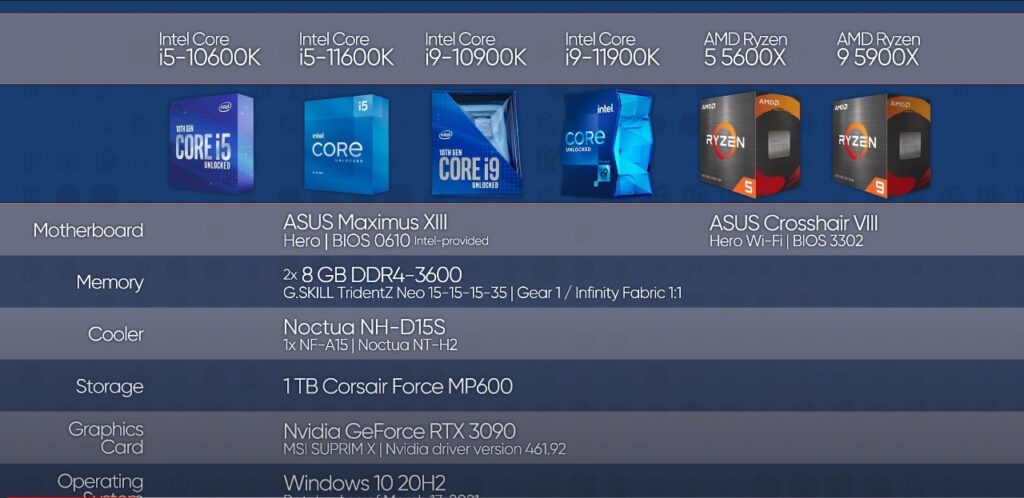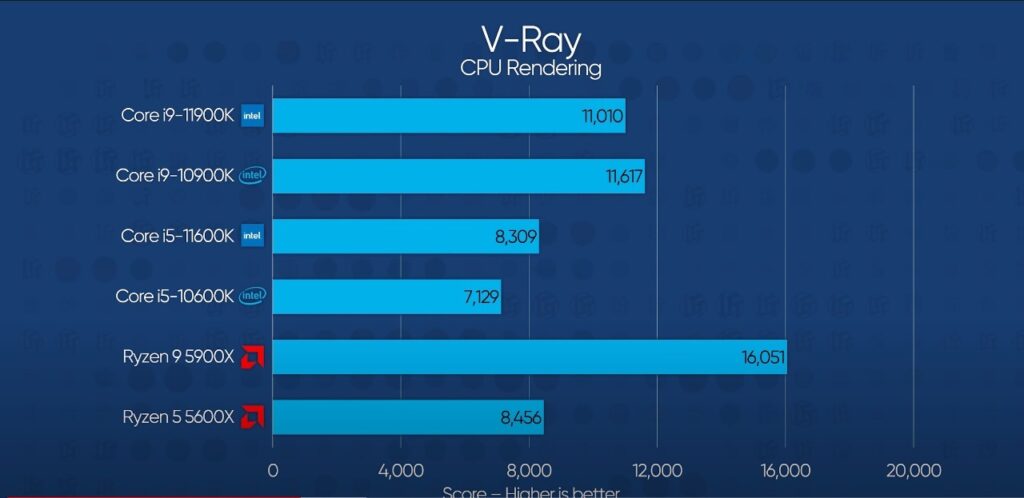14 nanometers! It’s bigger, quicker, and stronger than ever! I know that nanometers aren’t a precise measurement of something. However, this method is ancient, and it has significant performance ramifications, which we will measure on the Core I9-11900K and Core I5-11600K processors that we have here today.
To do this, we obtained identical 10th generation core processors. along with the Ryzen 5 5600X and Ryzen 9 5900X. It’s worth noting that we’re running both benches at one-to-one memory—more on that in a moment. And we’re conducting these experiments with fully stocked turbos.

The first Core I9 game is Shadow of the Tomb Raider. Ryzen 9 has an approximately 8% lower average FPS. The Core I5 achieves considerably higher minimum frame rates than the Ryzen 5. In GTA5, the Core I9 outperforms 5900X by 5% or more in minimum frames, while the Core I5 outperforms Ryzen 5’s minimums by 13% or so.

The ridiculous frame rates of F1 2020 are truly generational changes. Intel’s Core I5 is in control here. Because of fewer threads and lower base blocks, the Core I9 tends to be nearly on par with the 10th generation.
Intel and AMD are exchanging blows in Forza Horizon 4, with decent minimums and bad averages on both recent CPUs. Turn times in Civilization 6 are around a half-second or so faster on the 11th generation. Both CPUs outperform last-gen in Flight Sim 2020 but fall short of AMD in all but the lowest frame rates. Another bloodbath occurs in CSGO, where AMD’s Zen 3 architecture strongly curbs stomps rocket pool.
Perhaps as a result of Ryzen’s massive number of dollars. It’s worth noting, though, that every CPU on this list is already overkilled. Moving on to productivity, Intel’s single-threaded Cine bench scores are significantly higher than last-generation and somewhat higher than AMD’s, but not by much.

However, Puget Bench for Creative Cloud demonstrates that even lightly threaded workloads such as Photoshop can still favor AMD, again, most possibly due to the extra cash, But it’s not a significant loss. Blender is responsible for this. The Core I5 fell behind by 10% in Gooseberry, while the Core I9 is 40% slower than Ryzen in the same test due to the stock turbo. Since the Corona benchmark is much shorter, the Core I5 is much similar to Ryzen 5, and the same is true for V-Ray.
An examination that lasts for about a minute. Intel drives POV-Ray. POV-Ray puts Intel very close to AMD in single-threaded results, while the Core I9 continues to struggle. SPEC workstation is primarily another source of frustration for Intel. For several samples favoring the 10th generation Core I9 due to its extra cores and threads. Even the Core I5 suffers from aggregate scores that are 10 to 14 percent smaller than AMD in the life sciences, financial services, and energy segments of the exam.
So far, things aren’t looking well for the Core I9. But now we have to learn about strength in thermals, and we’re going to talk a lot about it. Since, as you can remember, Comet Lake was superior to Coffee Lake in terms of thermal efficiency, but only because Intel pulled out all the stops to make that possible. And now, despite possessing two fewer cores, all early studies had Rocket Lake pegged as essentially a flame thrower, in addition to AMD’s accuracy issues.
Both Core I9 and Core I5 have fair thermals out of the box. Once turbo expires, thanks in large part to strictly adhering to Intel’s rated 125-watt TDP. They use significantly more power than the previous generation when reaching their highest all-core turbo speeds, but in the case of the Core I9, Intel’s latest adapted boost technology enables the cores to run at 300 megahertz faster. It’s all more core than it’s classified for.
This new behavior is identical to AMD’s Precision Boosts Two, which increases all Core clocks opportunistically under thermal and power constraints. Still, Intel’s is also limited by their finite turbo time of 56 seconds by design. Using our motherboard’s multi-core enhancement functionality, we were able to disable this turbo cap. The Core I9 consumes a whopping 275 watts peak and 260 watts maintained from the socket. That is nearly double the power draw of the Ryzen 9 processor. And roughly 40% higher than the tenth generation. We did get19% faster render time than supply, but even with Noctua NHD 15S, the I9 immediately hits 80 degrees and creeps up to the mid-90s during the race.
Surprisingly, the Core I5 performs improved thermals and power draw with multi-core optimization relative to its stock turbo, owing to the motherboard’s lower core voltage. These outcomes, however, were for AVX 2.
Intel’s Rocket Lake processor also has the AVX 512 instruction set and machine learning extensions, and the company is relying heavily on marketing. We don’t currently have any benchmarks for that, but we can run a short stress test with Prime95.
Whereas our Core I9 has good thermals at stock, our Core I5 reaches 100 degrees due to a faster turbo speed before settling into the mid-60s to 70s. Power usage is comparable to non-AVX-512 checking, and unfortunately, both CPUs returned to the base clock after the turbo window expired. Until we delete the constraints again. At its max, the Core I9 processor will consume more than 290 watts. The Core I5 consumes less power due to the motherboard SPID regulation, but both CPUs are already hot enough to keep up our dual tower cooler barely. We’re pushing the boundaries of Intel’s reheated 14-nanometer process here.
With a water bottle from lttstore.com, you won’t have to reheat your drink for up to eight hours! Even without AVX-512, you have to wonder why the 11th generation is so hot, despite having fewer cores than the previous generation. Aside from taking up a lot of dye space, AVX-512 was initially designed for 10 nanometers. Yes, Intel had to backport this matter. .That’s why we have this strange-looking proc stack.
There are a total of ten eight-core CPUs around Core I7 and Core I9. There are nine six-core CPUs in the Core I5 line, and everything else is a Comet Lake refresh. There will be no Rocket Lake Core I3s or Pentiums this time. Without the ability to differentiate between skews using core counts, the disparities are so small in reality that most people would think twice about paying an additional $140 for a Core I9 when a Core I7 is almost as acceptable or when AMD is a stronger performer for the cost. Core I9s, on the other hand, get thermal velocity boost and adaptive boost technology. However, you can achieve the same effect by allowing multi-core enhancement on your motherboard or manually maxing out the power loads in Intel XTU if it does not.
We know both 11th generation core desktop CPUs have the same cash-for-core and upgraded graphic score with enhanced video decode capabilities on skews that include them.
Learn More About Latest News

